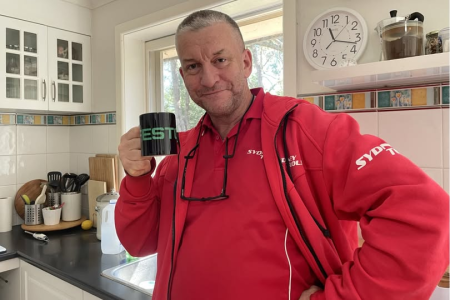Would you give a kidney to a stranger? One Aussie man quietly did
By
Maan
- Replies 0
Organ donation is often seen as a rare, selfless act—but the reality behind it is far more complex and deeply personal.
One Australian man's quiet decision set off a chain reaction that changed multiple lives across the country.
His story—and the growing need for more like it—highlights a national health challenge that too often goes unnoticed.
Decades ago, a story broadcast over the radio left a lasting impression on Melbourne man Steve Liston.
It wasn’t a tale of celebrity gossip or political scandal—it was about something far more intimate: the need for kidney donors. The idea of helping a stranger in such a profound way quietly took root in his mind and never left. Over time, the thought returned to him again and again.
‘It hit a nerve with me on so many levels, and it actually baffles me about why it doesn’t strike a nerve with more people,’ Liston, 57, said.
But turning a life-changing idea into action wasn’t something he rushed into.
When Liston first raised the possibility of donating one of his kidneys to a stranger, his children were still in school. Timing mattered. Years later, when his kids had become adults, he decided it was finally the right moment to act.
He began the process by visiting his GP and was told he’d need to lose 13 kilograms before becoming eligible as a donor. Liston took on the challenge and shed the weight, then underwent a battery of medical and psychological tests. When he was finally given the green light, he followed through with the donation.
His surgery went ahead a few years ago, and despite what many might assume, his recovery was smooth.
‘It’s not as big as people make it out to be,’ he said. ‘If you’re an office worker, you can actually be back to work in about two weeks. I had to be off for six weeks because lifting is involved in the work that I do, and there’s a risk of a hernia.’
The federal government’s Supporting Living Organ Donors program helped ease the burden, allowing him to claim up to 342 hours of paid leave at minimum wage, plus up to $1000 in out-of-pocket medical expenses.
Still, the most lasting benefit wasn’t financial.
‘Some people will achieve an Olympic gold, which is something they’ve worked very hard for and will have forever. Other people can do a doctorate and discover something new. But, for the average person who is never going to break a world record, or is not a genius, this is something almost anyone can do. I don’t get a buzz out of driving a nice car, or drinking fine wine. The biggest buzz I get is out of helping people.’
Liston’s kidney was given anonymously—as is required unless donating to someone known—and he had no desire to find out who received it.
‘I actually love the idea that it could be in anyone,’ he said.
That anonymous decision ended up creating an unexpected ripple effect. Because he wasn’t already paired with a recipient, his kidney kicked off a donation chain that matched over 10 people. He was told at the time it set an Australian record—one he hopes has already been broken.
But altruistic donations like Liston’s remain rare in Australia.
At any given time, roughly 1400 Australians are waiting for a kidney transplant. The average wait is 2.2 years, according to Kidney Health Australia. About two-thirds of transplants come from deceased donors, with the remainder from living donors.
Dr Stella McGinn, deputy director of the Australian and New Zealand Paired Kidney Exchange, explained that altruistic donors—those who give a kidney to a stranger—can be the key to unlocking multiple matches.
The program, run by the Royal Melbourne Hospital, allows people willing to donate to a loved one (but aren’t a suitable match) to be paired with others in the same situation. The exchange also accepts altruistic donors, though they were still relatively few in number.
In 2019, a partnership between the Australian program and New Zealand’s saw an uptick in these donations—from just a couple per year to around 10 in both 2022 and 2023. Last year, six people donated a kidney through the program, and three had done so this year.
The long-term benefits of a kidney transplant are considerable.
Over 94 per cent of kidney transplants in Australia were still working one year later, and those from live donors generally last longer. McGinn said it was not unusual for a transplant from a living donor to last around 20 years.
‘If you get a good kidney, and you look after it, it can see you for a very long time. A man in our hospital has got a deceased donor kidney, and he’s had it for 53 years,’ she said.
However, the need for transplants is increasing—and dialysis services are under pressure.
A recent article in the Medical Journal of Australia reported that approximately 15,500 people were undergoing dialysis for kidney failure, at an annual cost of around $1.9 billion. The growing demand was straining hospitals, particularly for patients from lower socioeconomic backgrounds. Some were receiving dialysis just twice a week instead of three, even with minimal kidney function remaining.
Seth Holm, a 24-year-old from Perth, knew that struggle all too well.
Born with his bladder outside of his body, Holm underwent numerous surgeries throughout his childhood. His kidneys failed when he was 14, and he spent two years on dialysis before receiving a transplant from his mother, Michelle Radis.
Although they weren’t a perfect match, the kidney worked for nearly seven years.
Holm is now back on dialysis after the donated kidney failed.
‘He was actually able to get a job for a short time—he did bricklaying for a bit and he loved it,’ Radis said.
Now, she said, her son was rarely well enough to leave the house.
‘Over the last two years, he’s had quite a lot of things go wrong, and he’s ended up in a coma twice, once from fluid overload and another time from COVID,’ she said.
Holm received dialysis every second day at home, each session lasting between four and six hours. He often felt exhausted afterward.
‘He gets really tired from dialysis,’ Radis said. ‘All he wants to do is get his life back…he said to me the other day he would do anything to be able to go out and work.’
Holm had recently been cleared to go back on the transplant list, but his earlier transplant left him with antibodies that made finding a match more difficult. With no remaining family members eligible to donate, Radis could only hope for a willing stranger.
‘Waiting on the deceased donor list is something I hope Seth doesn’t have to go through. I would give him my other kidney if I could.’
As organ donation rates struggle to meet demand, researchers are working behind the scenes on new ways to improve transplant success and access.
For those watching loved ones wait—or wondering what the future might hold—these breakthroughs could be life-changing.
Take a look at the latest developments giving patients new hope.
Source: Youtube/7NEWS Australia

With so many Aussies waiting and hoping, would you ever consider becoming a living organ donor to help a stranger in need? Let us know your thoughts in the comments.
In a previous story, we looked at how pigs might one day play a role in easing Australia’s transplant shortage—an idea that once sounded far-fetched but is fast becoming a real possibility.
For older Aussies watching medical breakthroughs with cautious optimism, innovations like these could be life-changing.
If the idea of a pig kidney saving a life intrigues you, that one’s definitely worth a look too.
Read more: Can pigs become a ‘beacon of hope’ in organ transplants and save lives?
One Australian man's quiet decision set off a chain reaction that changed multiple lives across the country.
His story—and the growing need for more like it—highlights a national health challenge that too often goes unnoticed.
Decades ago, a story broadcast over the radio left a lasting impression on Melbourne man Steve Liston.
It wasn’t a tale of celebrity gossip or political scandal—it was about something far more intimate: the need for kidney donors. The idea of helping a stranger in such a profound way quietly took root in his mind and never left. Over time, the thought returned to him again and again.
‘It hit a nerve with me on so many levels, and it actually baffles me about why it doesn’t strike a nerve with more people,’ Liston, 57, said.
But turning a life-changing idea into action wasn’t something he rushed into.
When Liston first raised the possibility of donating one of his kidneys to a stranger, his children were still in school. Timing mattered. Years later, when his kids had become adults, he decided it was finally the right moment to act.
He began the process by visiting his GP and was told he’d need to lose 13 kilograms before becoming eligible as a donor. Liston took on the challenge and shed the weight, then underwent a battery of medical and psychological tests. When he was finally given the green light, he followed through with the donation.
His surgery went ahead a few years ago, and despite what many might assume, his recovery was smooth.
‘It’s not as big as people make it out to be,’ he said. ‘If you’re an office worker, you can actually be back to work in about two weeks. I had to be off for six weeks because lifting is involved in the work that I do, and there’s a risk of a hernia.’
The federal government’s Supporting Living Organ Donors program helped ease the burden, allowing him to claim up to 342 hours of paid leave at minimum wage, plus up to $1000 in out-of-pocket medical expenses.
Still, the most lasting benefit wasn’t financial.
‘Some people will achieve an Olympic gold, which is something they’ve worked very hard for and will have forever. Other people can do a doctorate and discover something new. But, for the average person who is never going to break a world record, or is not a genius, this is something almost anyone can do. I don’t get a buzz out of driving a nice car, or drinking fine wine. The biggest buzz I get is out of helping people.’
Liston’s kidney was given anonymously—as is required unless donating to someone known—and he had no desire to find out who received it.
‘I actually love the idea that it could be in anyone,’ he said.
That anonymous decision ended up creating an unexpected ripple effect. Because he wasn’t already paired with a recipient, his kidney kicked off a donation chain that matched over 10 people. He was told at the time it set an Australian record—one he hopes has already been broken.
But altruistic donations like Liston’s remain rare in Australia.
At any given time, roughly 1400 Australians are waiting for a kidney transplant. The average wait is 2.2 years, according to Kidney Health Australia. About two-thirds of transplants come from deceased donors, with the remainder from living donors.
Dr Stella McGinn, deputy director of the Australian and New Zealand Paired Kidney Exchange, explained that altruistic donors—those who give a kidney to a stranger—can be the key to unlocking multiple matches.
The program, run by the Royal Melbourne Hospital, allows people willing to donate to a loved one (but aren’t a suitable match) to be paired with others in the same situation. The exchange also accepts altruistic donors, though they were still relatively few in number.
In 2019, a partnership between the Australian program and New Zealand’s saw an uptick in these donations—from just a couple per year to around 10 in both 2022 and 2023. Last year, six people donated a kidney through the program, and three had done so this year.
The long-term benefits of a kidney transplant are considerable.
Over 94 per cent of kidney transplants in Australia were still working one year later, and those from live donors generally last longer. McGinn said it was not unusual for a transplant from a living donor to last around 20 years.
‘If you get a good kidney, and you look after it, it can see you for a very long time. A man in our hospital has got a deceased donor kidney, and he’s had it for 53 years,’ she said.
However, the need for transplants is increasing—and dialysis services are under pressure.
A recent article in the Medical Journal of Australia reported that approximately 15,500 people were undergoing dialysis for kidney failure, at an annual cost of around $1.9 billion. The growing demand was straining hospitals, particularly for patients from lower socioeconomic backgrounds. Some were receiving dialysis just twice a week instead of three, even with minimal kidney function remaining.
Seth Holm, a 24-year-old from Perth, knew that struggle all too well.
Born with his bladder outside of his body, Holm underwent numerous surgeries throughout his childhood. His kidneys failed when he was 14, and he spent two years on dialysis before receiving a transplant from his mother, Michelle Radis.
Although they weren’t a perfect match, the kidney worked for nearly seven years.
Holm is now back on dialysis after the donated kidney failed.
‘He was actually able to get a job for a short time—he did bricklaying for a bit and he loved it,’ Radis said.
Now, she said, her son was rarely well enough to leave the house.
‘Over the last two years, he’s had quite a lot of things go wrong, and he’s ended up in a coma twice, once from fluid overload and another time from COVID,’ she said.
Holm received dialysis every second day at home, each session lasting between four and six hours. He often felt exhausted afterward.
‘He gets really tired from dialysis,’ Radis said. ‘All he wants to do is get his life back…he said to me the other day he would do anything to be able to go out and work.’
Holm had recently been cleared to go back on the transplant list, but his earlier transplant left him with antibodies that made finding a match more difficult. With no remaining family members eligible to donate, Radis could only hope for a willing stranger.
‘Waiting on the deceased donor list is something I hope Seth doesn’t have to go through. I would give him my other kidney if I could.’
As organ donation rates struggle to meet demand, researchers are working behind the scenes on new ways to improve transplant success and access.
For those watching loved ones wait—or wondering what the future might hold—these breakthroughs could be life-changing.
Take a look at the latest developments giving patients new hope.
Source: Youtube/7NEWS Australia
Key Takeaways
- Steve Liston's anonymous kidney donation sparked a record-breaking transplant chain after years of preparation and a lifelong desire to help.
- Living donor transplants, though rare in Australia, offer better long-term outcomes and can unlock multiple matches through paired exchanges.
- Kidney failure and dialysis needs are growing rapidly, with services strained and many patients receiving less-than-ideal care.
- Young patient Seth Holm, back on dialysis after a failed transplant, now faces a difficult wait for another donor amid serious health setbacks.
With so many Aussies waiting and hoping, would you ever consider becoming a living organ donor to help a stranger in need? Let us know your thoughts in the comments.
In a previous story, we looked at how pigs might one day play a role in easing Australia’s transplant shortage—an idea that once sounded far-fetched but is fast becoming a real possibility.
For older Aussies watching medical breakthroughs with cautious optimism, innovations like these could be life-changing.
If the idea of a pig kidney saving a life intrigues you, that one’s definitely worth a look too.
Read more: Can pigs become a ‘beacon of hope’ in organ transplants and save lives?








